The Fish Hook is an asterism formed by about a dozen bright stars in the constellation Scorpius. The curved star pattern forms the heart, body, tail, and stinger of the celestial Scorpion. Together with the Scorpion’s claws, the Fish Hook makes the constellation of Scorpius easily recognizable.
The asterism lies near the Teapot in Sagittarius, next to the bright band of the Milky Way galaxy. For northern observers, the Fish Hook and the Teapot dominate the southern evening sky during the summer months.
This region of the sky is populated by many bright deep sky objects, including the open clusters Messier 6 (the Butterfly Cluster), Messier 7 (Ptolemy’s Cluster) and NGC 6231 (the Northern Jewel Box), the nebulae NGC 6357 (the Lobster Nebula) and NGC 6334 (the Cat’s Paw Nebula), and the globular clusters Messier 4, Messier 19, and Messier 62. These bright clusters and nebulae can be found using the stars of the Fish Hook.
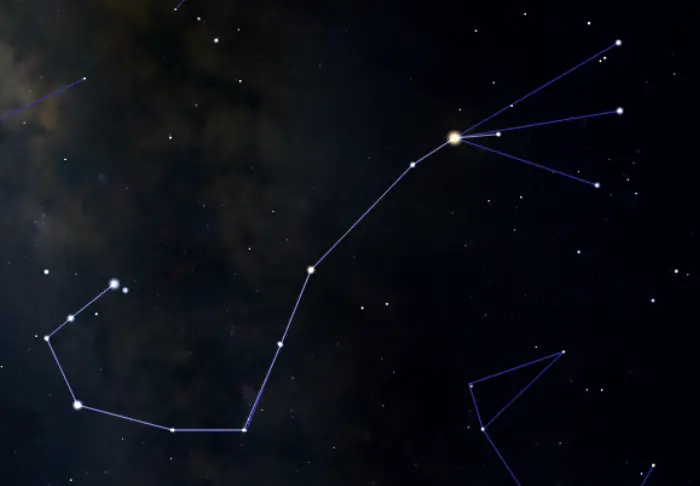
The Fish Hook in Scorpius, image: Stellarium
Constellation
The Fish Hook lies in the constellation Scorpius. The stars of the Fish Hook are part of the celestial Scorpion’s constellation figure. They outline the body, tail, and stinger of Scorpius.
The red supergiant Antares, the constellation’s brightest star, marks the Scorpion’s heart. Alniyat and Paikauhale, the two stars flanking Antares, are traditionally seen as the arteries. Shaula, the second brightest star in the constellation, marks the Scorpion’s stinger with the fainter Lesath. The stars between Paikauhale and Shaula – Larawag, Pipirima and Xamidimura, Zeta Scorpii, Eta Scorpii, Sargas, Iota1 Scorpii, and Kappa Scorpii – form the rest of the Scorpion’s body and tail.
The Fish Hook forms most of the constellation figure of Scorpius. The three bright stars west of Antares and Alniyat – Acrab, Dschubba, and Fang – represent the Scorpion’s claws.
In Polynesia, the constellation Scorpius was known as Manaiakalani. In local lore, Manaiakalani was the god Maui’s magical fishhook with which he pulled the Hawaiian Islands off the ocean floor, caught the Sun, and slowed it down to create longer days during the summer season.
Ancient Greeks associated Scorpius with the scorpion that stung Orion. In Greek mythology, Orion was a giant huntsman who boasted that he could defeat any living creature on Earth. This offended the goddess Gaia, who sent a giant scorpion to do away with the hunter. It is said that the constellations Scorpius and Orion were placed on opposite ends of the sky so that they would never meet. In the northern hemisphere, Orion dominates the winter sky, while Scorpius is prominent during the summer months.
Location
The Fish Hook appears south of the celestial equator and is best seen from the southern hemisphere, where it climbs much higher above the horizon. Observers in the northern hemisphere can see the asterism during the summer months, when it is visible near the Milky Way’s band above the southern horizon. It appears west of the Teapot in Sagittarius.
The southernmost stars of the Fish Hook – Sargas, Eta and Zeta Scorpii – may not rise at all for observers in the mid-northern latitudes. At declinations 42-43° S, they are visible from locations south of the latitude 46° N.
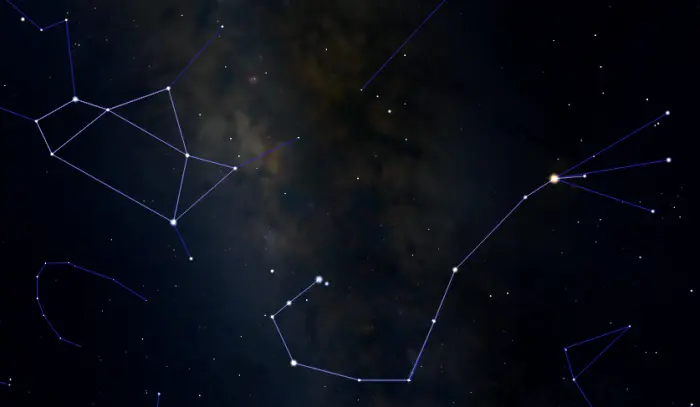
The Teapot in Sagittarius and the Fish Hook in Scorpius, image: Stellarium
Deep sky objects
The Fish Hook can be used to find many deep sky objects that appear in the same area of the sky. Some of these are visible to the unaided eye on a clear, dark night while others require larger telescopes.
Antares can be used to find the globular clusters Messier 4 and Messier 80. M80 appears roughly halfway between Antares and Acrab, the northernmost of the bright stars that form the Scorpion’s claws. M4 appears closer to the supergiant, about 1.3 degrees to the west. It forms a triangle with Antares and Alniyat.
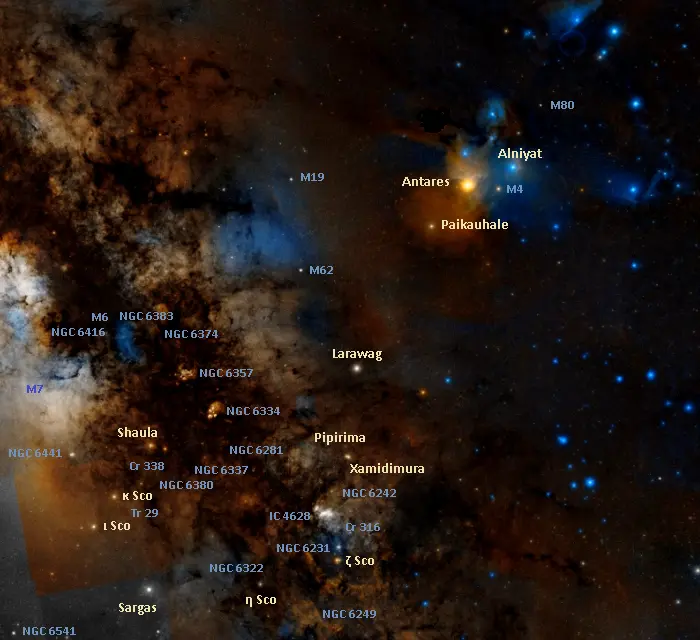
The deep sky objects near the Fish Hook, image: Wikisky
The globular clusters Messier 19 and Messier 62 in the constellation Ophiuchus can be found using Larawag. M62 lies 4.75 degrees northeast of the star, while M19 appears a little less than halfway between Larawag and Sabik in Ophiuchus.
The region between Mu and Zeta Scorpii contains several open clusters, including the Northern Jewel Box (NGC 6231), NGC 6242, Trumpler 24, and Collinder 316.
The Northern Jewel Box Cluster lies half a degree north of Zeta Scorpii and marks the head of the False Comet, an asterism comprised of several stars and star clusters in this area. The Prawn Nebula (IC 4628), a bright, large emission nebula, and the open clusters Collinder 316 and Trumpler 24 form the Comet’s tail. The tail ends with the open cluster NGC 6242 near the visual pair Xamidimura and Pipirima (Mu1 and Mu2 Scorpii).
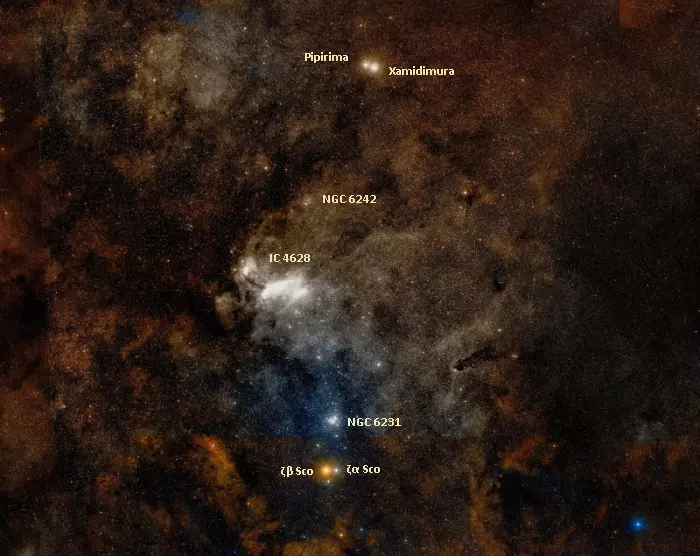
The False Comet, image: Wikisky
The open cluster NGC 6249 forms an almost equilateral triangle with Zeta and Eta Scorpii. Another open cluster, NGC 6322, is found along the imaginary line connecting Sargas and Zeta Scorpii, near Eta Scorpii.
The bright globular cluster NGC 6541 in the constellation Corona Australis lies in the same area as Sargas, along the line extended from Kappa through Iota Scorpii.
The Cat’s Paw Nebula (NGC 6334), a large star-forming nebula, appears about two thirds of the way from Larawag to Shaula at the Scorpion’s stinger. Another prominent emission nebula, popularly known as the Lobster Nebula or War and Peace Nebula (NGC 6357), appears to the northeast of the Cat’s Paw. The bright open cluster NGC 6281 lies to the southwest.
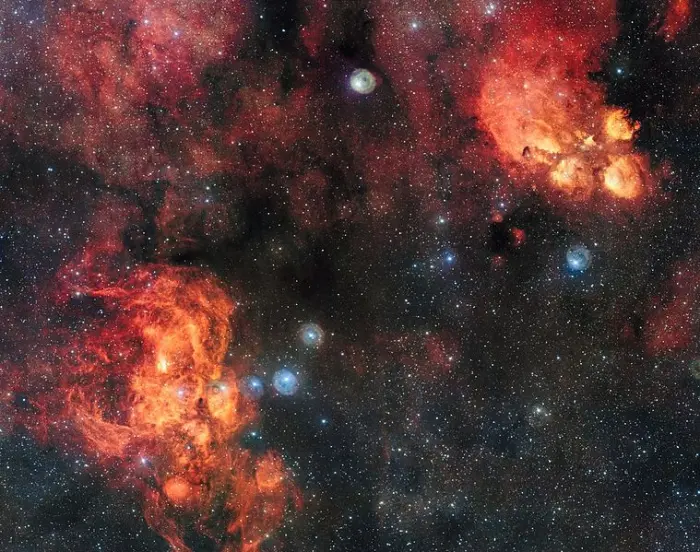
This spectacular image from the VLT Survey Telescope shows the Cat’s Paw Nebula (NGC 6334, upper right) and the Lobster Nebula (NGC 6357, lower left). These dramatic objects are regions of active star formation where the hot young stars are causing the surrounding hydrogen gas to glow red. The very rich field of view also includes dark clouds of dust. With around two billion pixels this is one of the largest images ever released by ESO. Note that the circular features in the image around bright stars are not real, they are due to reflections within the optics of the telescope and camera. Image credit: ESO (CC BY 4.0)
The Butterfly Nebula (NGC 6302) and the Cheerio Nebula (NGC 6337) appear in the same area of the sky. The Butterfly Nebula (or Bug Nebula) is a bright bipolar planetary nebula, and the Cheerio Nebula is a much smaller and fainter toroidal planetary nebula.
Kappa Scorpii can be used to find the open clusters Collinder 338 and Trumpler 29, and the globular cluster NGC 6380. Another globular cluster, NGC 6441, forms a triangle with Kappa Scorpii and Shaula.
The region of Scorpion’s stinger is populated by several bright star clusters. The open clusters Messier 6 (the Butterfly Cluster) and Messier 7 (Ptolemy’s Cluster) can be found using Shaula and Lesath. The Butterfly Cluster lies 5 degrees north and 1.5 degrees east of Shaula and Ptolemy’s Cluster lies 4.75 degrees northeast of the star. The open cluster NGC 6416 appears just east of M6, while NGC 6383 and NGC 6374 lie to the west.
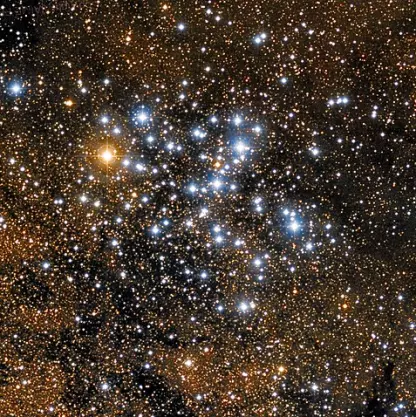
Messier 6 (the Butterfly Cluster), image: Giuseppe Donatiello (CC0 1.0)
Stars
The Fish Hook is formed by Alniyat (Sigma Scorpii), Antares (Alpha Scorpii), Paikauhale (Tau Scorpii), Larawag (Epsilon Scorpii), Pipirima (Mu2 Scorpii) and Xamidimura (Mu1 Scorpii), Zeta Scorpii, Eta Scorpii, Sargas (Theta Scorpii), Iota1 Scorpii, Kappa Scorpii, and Shaula (Lambda Scorpii). Some observers omit Alniyat, while others include Lesath (Upsilon Scorpii) at the Scorpion’s stinger.
Most of these stars are members of the same stellar family, the Upper Scorpius subgroup of the Scorpius-Centaurus OB association. The Sco-Cen (Sco OB2) association is composed of young, hot, massive O- and B-type stars located at an average distance of 420 light-years.
The members of the Upper Scorpius subgroup have an average age of 11 million years. Many of these stars have already evolved away from the main sequence despite their young age and are massive enough to go out as supernovae. They are tens of thousands of times more luminous than the Sun.
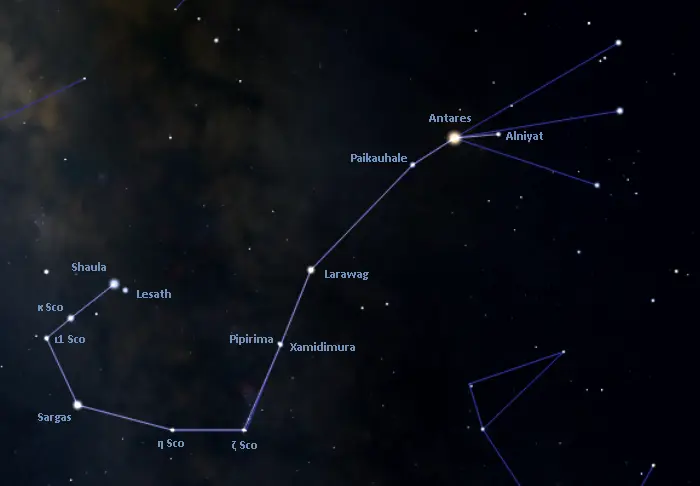
The stars of the Fish Hook, image: Stellarium
Antares
Antares (Alpha Scorpii) is the brightest star in Scorpius and the 15th brightest star in the sky. It is a red supergiant of the spectral type M1.5Iab-Ib, located approximately 550 light-years away. The star is classified as a slow irregular variable (type Lc). Its brightness has been observed to vary from magnitude 0.6 to 1.6.
Antares has a mass between 11 and 14.3 times that of the Sun and a radius of about 680 solar radii. It started its life with a mass of 15-17 solar masses but has gradually lost a lot of its material through a strong stellar wind. The supergiant’s radius varies by about 19% due to pulsations.
With an effective temperature of around 3,660 K, Antares is 75,900 times more luminous than the Sun. Even though it is a young star, with an estimated age of only about 15 million years, it has evolved quickly due to its high mass. When it reaches the end of its life cycle, it will go out as a brilliant supernova.
Antares has a companion, Alpha Scorpii B (Antares B), a hot blue main sequence star with the stellar classification B2.5V. The companion shines at magnitude 5.5 and would be visible in small telescopes if not for the glare from the brighter supergiant.
Antares B has a mass of 7.2 solar masses and a radius 5.2 times that of the Sun. With a surface temperature of 18,500 K, it shines with 2,754 solar luminosities. The star is a very fast spinner, with a projected rotational velocity of 250 km/s.
Antares marks the celestial Scorpion’s heart. It is flanked by two relatively bright stars, Alniyat and Paikauhale. These stars were both historically known as Al Niyat, the arteries.
The name Antares comes from the Greek Ἀντάρης, meaning “rival to Mars.” It refers to the star’s brightness and red colour, which make it similar to the planet Mars in appearance.
Shaula
Shaula (Lambda Scorpii) is a hot blue subgiant star in a triple star system located approximately 570 light-years away. With an apparent magnitude of 1.62, it is the second brightest star in Scorpius and, on average, the 24th brightest star in the sky. Together with the fainter Lesath (Upsilon Scorpii), it marks the Scorpion’s stinger.
Shaula has a mass 10.4 times that of the Sun and a radius 8.8 times the Sun’s. With a surface temperature of 25,000 K, it is 36,300 times more luminous than the Sun. The star is classified as a Beta Cephei variable. Its brightness varies rapidly by about a hundredth of a magnitude.
Shaula has two companions, a young pre-main sequence star with an orbital period of 6 days and a B-type star with a period of 1,053 days.
The name Shaula comes from the Arabic al-šawlā´, meaning “the raised (tail).”
Sargas
Sargas (Theta Scorpii) is the primary component in a binary star system located about 329 light-years away. With an apparent magnitude of 1.87, it is the third brightest star in Scorpius, after Antares and Shaula.
Sargas is classified as a bright giant of the spectral type F0 II. It has a mass of 3.10 solar masses and a radius 26.3 – 35.5 times that of the Sun. Its equatorial radius is 19% larger than its polar radius due to the star’s high spin rate. With a projected rotational velocity of 125 km/s, Sargas completes a rotation in 16.6 days.
The bright giant is 1,400 times more luminous than the Sun and has an effective temperature of 6,294 K.
The companion, Theta Scorpii B, is separated by 0.538 arcseconds from the primary.
The origin of the name Sargas is uncertain. It may come from the Persian word for “arrow head” or from the Sumerian ŠAR.GAZ, referring to a weapon of the god Marduk.
Larawag
Larawag (Epsilon Scorpii) is an orange giant of the spectral type K1 III. It shines at magnitude 2.310 and lies 63.7 light-years away. It has a mass of 1.24 solar masses and a radius 12.6 times that of the Sun.
The name Larawag comes from the culture of the Wardaman people in the Northern Territory of Australia. It means “clear sighting” and is associated with an initiation ceremony.
Kappa Scorpii
Kappa Scorpii is a spectroscopic binary star with an orbital period of 195.65 days. It lies 480 light-years away and has a visual magnitude of 2.41-2.42. It has the spectrum of a blue giant of the spectral type B1.5 III.
The primary component, Kappa Scorpii A, has a mass 17 times that of the Sun, which makes it a supernova candidate. The star has a radius of 6.8 solar radii. With a surface temperature of 23,400 K, it is 6,911 times more luminous than the Sun. It has an estimated age of 25.1 million years.
Like Shaula, Kappa Scorpii A is classified as a Beta Cephei variable. Its brightness varies due to radial pulsations with a dominant period of 4.8 hours.
The secondary, Kappa Scorpii B, is also destined to go out as a supernova. It has a mass of 12 solar masses and a radius 5.8 times that of the Sun. It is slightly cooler than the primary, with an effective temperature of 18,800 K.
Kappa Scorpii does not have a proper name approved by the International Astronomical Union (IAU). It has traditionally been known as Girtab. The name was derived from the Sumerian word for “scorpion.” It originally applied to an asterism formed by Kappa and Iota Scorpii with Shaula (Lambda Scorpii) and Lesath (Upsilon Scorpii).
Paikauhale
Paikauhale (Tau Scorpii) is another massive, hot, blue star in Scorpius. It shines at magnitude 2.82 from a distance of 470 light-years. The star has a mass 12 times that of the Sun and a radius 6.5 times solar. With a surface temperature of 31,440 K, it shines with 20,400 solar luminosities. It has an estimated age of only 5.7 million years.
Tau Scorpii is one of the two bright stars flanking Antares, the heart of the Scorpion. It and the fainter Alniyat were historically known as Al Niyat, meaning “the arteries.”
Paikauhale is the traditional Hawaiian name for Tau Scorpii. The word means “vagabond owning no home” or “house-to-house wanderer.”
Alniyat
Alniyat (Sigma Scorpii) is a blue giant in a multiple star system located around 568 light-years away. It has a mass about 18 times that of the Sun and a radius 12.7 times solar. With a surface temperature of 26,150 K, it is 29,000 times more luminous than the Sun. The star has an estimated age of 8 million years.
Like Shaula and Kappa Cephei, Alniyat is a Beta Cephei variable. Its brightness varies between magnitude 2.86 and 2.94 due to pulsations.
Alniyat has a spectroscopic companion, a B-type main sequence star, and two other more distant companions. The name Alniyat comes from the Arabic word for “the arteries.”
Iota1 Scorpii
Iota1 Scorpii is a supergiant star with the stellar classification F2 Ia. It shines at magnitude 3.03 from a distance of 1,900 light-years. It has a 10th magnitude companion at a separation of 37.5 arcseconds.
The star has a mass of 12.1 solar masses and a radius between 125 and 400 times that of the Sun. It is 18,249 times more luminous than the Sun and has an effective temperature of 6,910 – 7,103 K. It is believed to be 17 million years old.
The star shares the Bayer designation Iota Scorpii with Iota2 Scorpii, a class A supergiant located approximately 2,500 light-years away. The two stars are not physically related. They are separated by 0.50 degrees in the sky.
Xamidimura and Pipirima
Xamidimura and Pipirima share the Bayer designation Mu Scorpii. They are separated by 0.1 degrees in the sky. The two star systems were once believed to be physically related, but modern distance estimates indicate that they are not. They are, however, both members of the Sco OB2 association.
The two components of Mu1 Scorpii have a combined visual magnitude of 3, and Mu2 Scorpii shines at magnitude 3.56.
Xamidimura (Mu1 Scorpii) is the primary component in a binary star system located approximately 500 light-years away. Both components are hot blue B-type main sequence stars. Mu1 Scorpii A has a mass 8.3 times that of the Sun and a radius 3.9 times the Sun’s, while Mu1 Scorpii B has 4.6 times the Sun’s mass and a radius of 4.6 solar radii. Both stars are exceptionally fast spinners, with projected rotational velocities of 191.5 and 165.0 km/s.
The stars orbit each other with a period of 1.44627 days. The system has a semi-major axis of 12.90 solar radii. It is classified as a Beta Lyrae variable. Beta Lyrae stars are close binary stars that periodically block each other’s light as they orbit. These are massive stars whose shapes are heavily distorted by mutual gravitation forces. They have ellipsoidal shapes and there are mass flows occurring from one component to the other. The brightness of Mu1 Scorpii dims by 0.3 and 0.4 magnitudes when the components occult each other.
The Mu1 Scorpii system is a semidetached binary star. One of the stars fills the companion’s Roche lobe (the region around the star within which material is gravitationally bound to it) and the inflowing gas forms an accretion disk around the companion.
The name Xamidimura comes from the Khoekhoe xami di mûra, meaning “the eyes of the lion.”
Pipirima (Mu2 Scorpii) is classified as a hot blue subgiant of the spectral type B2IV. It lies approximately 474 light-years away and is a member of the Upper Centaurus-Lupus subgroup of Sco OB2.
The star has 8.7 times the Sun’s mass and a radius 7 times that of the Sun. With a surface temperature of 23,113 K, it shines with 2,385 solar luminosities. It has an estimated age of 18.5 million years.
Two candidate planets were detected orbiting the star in 2022. The outer one, Mu2 Scorpii b, has ben confirmed and the inner one, Mu2 Scorpii c, has not. Mu2 Scorpii b is a gas giant with a mass 14.4 times that of Jupiter. It takes 1,251.8 years to complete an orbit around its parent star. It orbits at an average distance of 242.4 astronomical units.
The name Pipirima comes from a traditional Tahitian story of Pipiri and Rehua, a brother and sister who flee their parents and become stars in the sky.
Eta Scorpii
Eta Scorpii is the southernmost of the Scorpius stars with a Bayer designation. It is a yellow-white subgiant star of the spectral type F5 IV, located approximately 73.5 light-years away.
The star has a mass of 1.75 solar masses and a radius 3.307 times solar. It is 17.94 times more luminous than the Sun and has an effective temperature of around 6,533 K.
Eta Scorpii is an exceptionally fast spinner, with a projected rotational velocity of 150 km/s. The star has an estimated age of 1.1 billion years.
Zeta1 and Zeta2 Scorpii
Zeta1 and Zeta2 Scorpii form a visual pair but are in fact unrelated stars that happen to lie in the same line of sight. Zeta1 Scorpii has an apparent magnitude of 4.705 and lies 8,200 light-years away and the brighter Zeta2 Scorpii shines at magnitude 3.59-3.65 from a distance of 132 light-years.
Zeta1 Scorpii is one of the most luminous stars known in the Milky Way. It is a B-type hypergiant and a candidate luminous blue variable (LBV). It has a mass 36 times that of the Sun and a radius 103 times the Sun’s. With a surface temperature of 17,200 K, it is 850,000 times more luminous than the Sun. The star has an estimated age of only 6.5 million years.
Zeta1 Scorpii may be an outlying member of the Northern Jewel Box (NGC 6231), a young open cluster that forms the head of the False Comet. With an apparent magnitude of 2.6, the cluster is visible to the unaided eye on a clear night. It is best observed in binoculars and small telescopes.
Zeta2 Scorpii is an orange giant of the spectral type K4 III. It has a mass of 1.19 solar masses and a radius 21 times that of the Sun. The star is believed to be 5.80 billion years old.
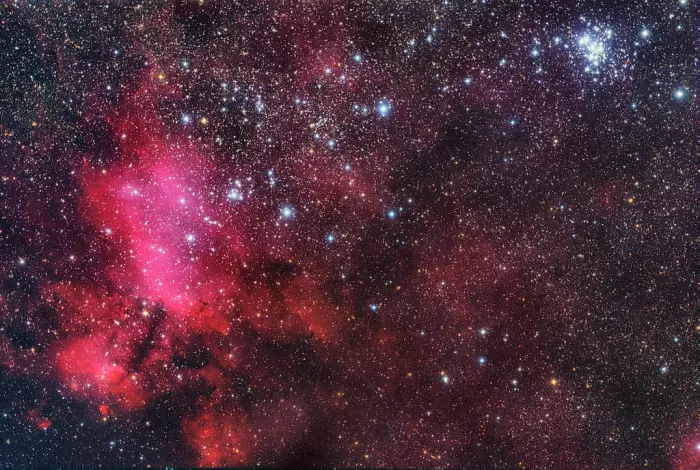
The Prawn Nebula (IC 4628) is an emission nebula and star-forming region located in the constellation of Scorpius. Due to the presence of hydrogen-rich gas clouds, it glows in a reddish hue when high energy radiation from massive stars ionize the interstellar gas cloud. Beside the Prawn Nebula is a bright star cluster known as the Northern Jewel Box or False Comet. Designated as NGC 6231, it appears to leave a trail of stars leading to IC 4628. Image credit: Ivan Bok (CC BY 4.0)